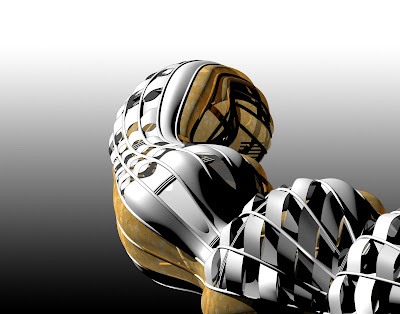
Here is a jpg 1680 x 1050 px that I made for my wallpaper. I showed you mine now show me yours. If you want, post an image at 300 dpi with the same size and add it to this post. That way we can have a collection of microCOSM wallpapers.


 This is a conceptual representation of a series of four spaces formed initially around a waterjet cutter. The spaces were generated using the script from proj_02 and manual modelling. The parameters were changed to make a series of spaces with similar relationships to my proj_04 diagrams. Each space is smaller than the one before and less connected to the group/active areas. The structure is made using pipe bending technology. I mapped an image of my proj_01 wax pods onto the skin of the spaces. The panels making the skin could be fabricated with a cnc mold and vacuum formed plastic. I have plans for using proj_03 as a second outer skin that could also peel away from the structure to form covered outdoor spaces. The gyroscoping elements are currently only used to aid modelling but will be developed into structural thresholds locking the pipes together and allowing people to pass through.
This is a conceptual representation of a series of four spaces formed initially around a waterjet cutter. The spaces were generated using the script from proj_02 and manual modelling. The parameters were changed to make a series of spaces with similar relationships to my proj_04 diagrams. Each space is smaller than the one before and less connected to the group/active areas. The structure is made using pipe bending technology. I mapped an image of my proj_01 wax pods onto the skin of the spaces. The panels making the skin could be fabricated with a cnc mold and vacuum formed plastic. I have plans for using proj_03 as a second outer skin that could also peel away from the structure to form covered outdoor spaces. The gyroscoping elements are currently only used to aid modelling but will be developed into structural thresholds locking the pipes together and allowing people to pass through.
Some interesting work on building blog.."Sand/Stone"
"One of the most interesting aspects of the project, I think, is that this solidified dunescape is created through a particularly novel form of "sustainable construction" – that is, through a kind of infection of the earth. In other words, Larsson has proposed using bacillus pasteurii, a "microorganism, readily available in marshes and wetlands, [that] solidifies loose sand into sandstone," he explains. "

Crazy flock of swallows flying over Rome.
What rule system could generate this behavior?



 Some cool images of work going on at Yale.
Some cool images of work going on at Yale.






In previous versions of the "individual and the group", most students have developed strongly isolated spaces for individual refuge. I feel individual refuge is important, but not at a collaborative workplace--refuge is for home.
Question: How will removing places of individual refuge in a design studio affect collaboration and creativity?

I like the mix of direct and absorbed light in the wax model. One of the panels had extra bees wax which does give it more color variation as you move past it.
I thought that the structural enclosure model ended up very dense and opaque, but with direct light shining on the outer surface the inside gets a nice reflected effect. The white paper on the outside is coloring the light seen in the photo. If the model is turned around the same effect is not made by the brown chipboard.
So as far as process goes the act of photographing these models gave me more ideas that I will try to employ in project 5. Would I have found these properties without the blog?